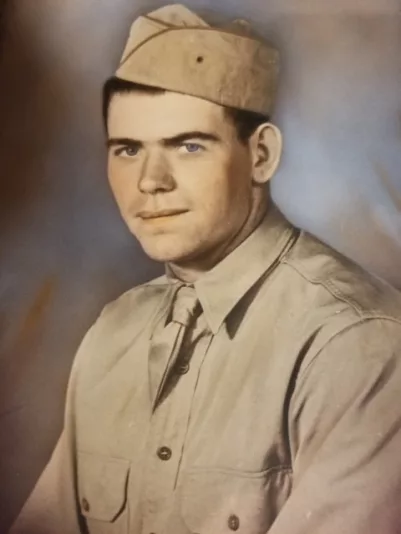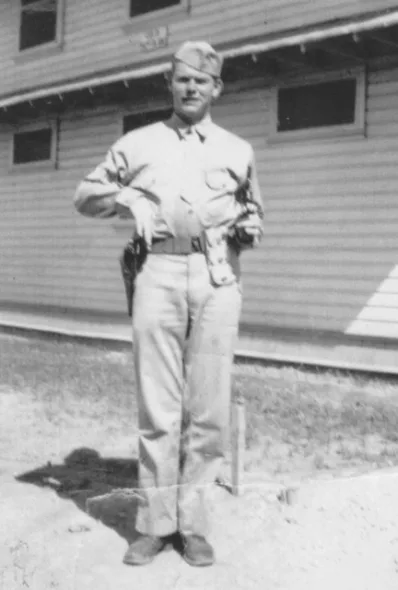
U.S. Army Private First-Class Thomas Franklin “Frank” Brooks will be laid to rest near his childhood home in Edmonson County on Sunday, October 1, 2023, as the community honors his ultimate sacrifice, having died as a prisoner of war in the Philippines during WWII at the age of 23 on December 10, 1942.
He joined the U.S. Army in January 20, 1941, and served at Fort Knox, Louisiana and the Philippines. Frank was in the first combat unit to arrive in the Philippines just a few days before the islands were invaded by the Japanese. He fought in the Battle of Bataan, which lasted nearly four months, and was one of the deadliest battles of the war.
Frank was there as thousands of men marched in the “Bataan Death March” to the Cabanatuan POW camp in Northern Luzon, Philippines. He was wounded and admitted to a field hospital on Bataan before being transferred to the prison camp in May 1942 where he survived for over eight months. He was buried in a mass grave with eight other men just outside of the prison camp in a shallow grave, dug by other soldiers in the prison camp.
Since Frank’s death in 1942, his remains along with thousands of others have been moved and disturbed several times in attempts to identify them. Finally, on June 21, 2023, multiple DNA tests confirmed his identity and he has returned to the country he died to protect; to the county that never stopped searching for him; and to his family that never stopped loving him.
Frank was born October 3, 1919, and raised in Edmonson County, near Mammoth Cave National Park. He was the seventh of 12 children, and of the six males, five served in the military — Three served in WWII, and one served in the Navy in the 1930s. His parents, Charles Smith and Francis Isabell Priddy Brooks, were farmers, loggers and owned a small country store.
Frank along with his brother Easol traveled to Louisville to join the Army. Easol was assigned to Ft. Hood, Texas, and Frank was assigned to the 192nd Tank Battalion at Fort Knox. His company of 97 members was comprised almost completely of men from Kentucky, known as the “Harrodsburg Tankers.”
His unit was requested by General Douglas MacArthur and was evaluated during maneuvers by Major General George S. Patton who noted: “That is the finest tank unit I have ever seen.”
While he was assigned close to home, Frank traveled home and invited fellow soldiers to accompany him to enjoy home cooking, family and friends. The journey home involved multiple modes of transportation, including bus transport of about 50 miles from Fort Knox to Park City, then a road of hitchhiking through Mammoth Cave National Park to the Green River Ferry, and walking approximately 10 miles home. There were no phones to announce their impending arrival.
His last visit home was in the summer of 1941.
“The large family was loving and accepting of his friends” said his great nephew, Gerald Carroll, a retired member of the U.S. Army, who recalled that Frank’s mother would ask about his friends in letters to the Army after he went missing. “It was years and years of no answers and his parents and siblings died without knowing what happened to Frank.”
Frank’s company trained diligently to prepare for probable deployment in 1941, participating in the Louisiana maneuvers across the U.S. southern states. Frank wrote a postcard home from Tremont, Louisiana on August 6, 1941, that he “was having a fairly good time and the hot weather and mosquitos are terrible but I can take it, I guess.”
The 192nd Battalion arrived in the Philippines on November 20, 1941, and 18 days later, on Dec 8, 1941, Frank and his fellow soldiers received their baptism by fire when the Japanese attacked U.S. and Filipino forces on the islands.
Frank and his unit were in almost constant close combat with the Japanese. They fought valiantly without reinforcements or resupply until ordered by their superiors to surrender in April 1942. The soldiers who could not escape were forced to endure the infamous “Bataan Death March” as prisoners of war. Only 37 of the original 66 Harrodsburg Tankers survived captivity.
During the fighting, Frank was wounded and admitted to a field hospital on Bataan. The extent of his injuries is unknown. History indicates that the Japanese allowed the hospitals to continue to operate until the U.S. forces on Corregidor eventually fell about a month later and the hospitals were closed.
Frank was transferred in May 1942 to the prison camp. Conditions in the camp were horrific with rampant malnutrition and disease, as well as unspeakable brutality from the Japanese military. Over 2,700 soldiers died in the camp as unknowns.
Left in the Philippines
After the Japanese surrendered and the war ended on August 15, 1945, there were multiple efforts to identify the men who were buried in the prison camps. Those efforts were partially successful as six of the eight men buried with Frank were identified, but Frank and two others were buried together as unknowns in January 1950. They were among the 17,000 buried in the Manila American Cemetery in the Philippines. There were, in total, 36,286 missing soldiers who were lost at sea and in aircraft losses.
He remained buried as an unknown from 1950-2018, when the Defense POW/MIA Accounting Agency exhumed the remains and began the analysis of DNA, making a positive identification 81 years after his death.
“Frank’s family was never informed as to what happened,” Carroll said, “and each of his siblings died without knowing the story of his death or what happened to him. The family made many inquires over the years, but no satisfactory answers were received; however, we are grateful that we know more of what happened and that his life and his death is relevant again.”
Community involvement and appreciation
The family invites the public to celebrate his life and legacy as they prepare for his homecoming. At this time, details are unavailable as to when his remains will arrive. A graveside service will be held on Sunday, October 1, 2023, at 11:00 a.m. at Hill Grove Missionary Baptist Cemetery in Mammoth Cave. Frank will be buried with full military honors.
Individuals and businesses along the procession route are encouraged to create patriotic displays of American Flags and yellow ribbons.
“We are so appreciative of the Patriotic displays of the American flag and yellow ribbons, and so many acts of kindness. Our family is deeply honored,” Carroll said.
(Headline photo: U.S. Army Private First-Class Thomas Franklin Brooks, submitted by the family)

By Paula L. Rafliff









